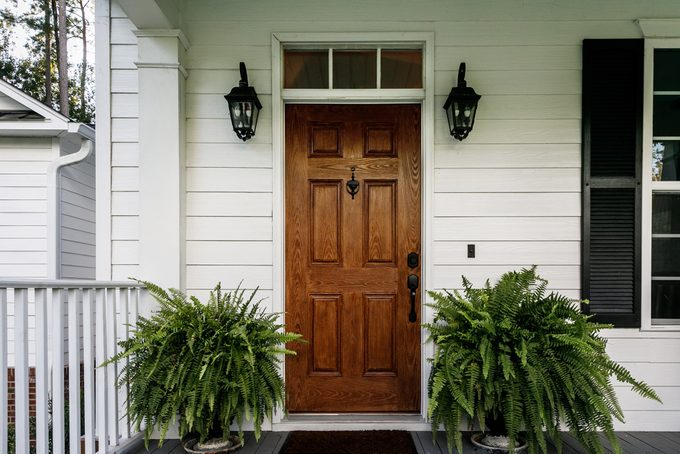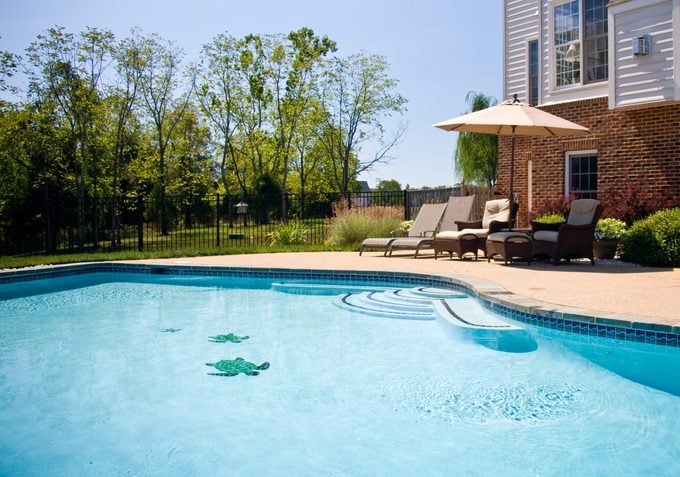13 Things You Didn’t Realize Homeowners Insurance Won’t Cover
Updated: Nov. 25, 2022
Don't get caught holding the bills when uncovered disasters strike. Make sure you're covered for these liabilities.

If you think your homeowner’s insurance automatically protects you against anything and everything, you may be in for a shock. It turns out that there’s quite a bit missing from all that fine print that you may or may not have actually read. We spoke with Mike Gulla, Senior Director of Underwriting at Hippo Insurance, to find out what isn’t covered by the average homeowner’s insurance policy—and what you can do instead.
Service line connections
“The water, sewage, and even electrical lines that connect your house to the street aren’t covered by most home insurance policies or the city,” Gulla explains. “So the homeowner is responsible for any damage that may incur.” Luckily, there’s a simple solution appropriately called service line coverage. This policy addendum not only helps cover any losses from faulty pipes or wiring that you’re legally responsible for, but it will also help pay for necessary repairs to the lines themselves. If you’re potentially buying a house, be sure those service lines get inspected; here are 15 more questions to ask before buying your first home.
Water backup
Gulla cautions that any water that backs up into your home due to pump problems isn’t typically covered. That’s not good when you consider that 25 percent of all property damage claims from 2009 to 2013 were caused by water damage or freezing. To save yourself (and your home), consider adding water backup coverage to your policy. The coverage amounts vary based on where you live but can run anywhere from $5,000 to $25,000.
Certain dog breeds
You might love your pit bull, but your insurance company? Not so much. Especially because in 2015, insurers spent $570 million on claims related to dog injuries alone. Many companies now have lists of prohibited breeds that include those that are often considered dangerous, such as pit bulls, Rottweilers, and German Shepherds. If you have one of those breeds or a dog with a history of biting, look for an insurance provider that accepts all animals.
Earthquakes
Homeowners who live in states that are susceptible to earthquakes, like California or Alaska, are advised to purchase a separate earthquake insurance policy along with homeowners insurance. The average cost of these policies is between $100 and $300 but can be as high as $800 depending on how close you live to a fault line. Pro tip: Find out if your state offers discounts, too. For instance, in California, you’ll pay less if your home is reinforced by an earthquake-resistant bracing system.
Floods
Similar to earthquakes, floods require supplemental flood insurance or a flood damage rider. This coverage is highly recommended if you live in a flood zone or even in a region that gets hit by hurricanes frequently. In 2016, the average insurance cost was $700, according to FEMA, and covers almost all personal property with the exception of anything stored in a basement or any living expenses you incur if the flood forces you to temporarily relocate.
Pools
“A pool can be a great addition to your home and property value but it comes with a big change in your liability insurance,” Gulla warns, “particularly if you plan to have guests swimming in your pool.” That’s because a swimming pool is what insurance companies call “an attractive nuisance,” meaning it comes with benefits and risks. Those risks will push your monthly premium higher based on factors like where you live and even where your pool is located (you’ll pay more if your pool is visible from the street, for example).
Nuclear hazards
While homeowners insurance oddly enough does cover unbelievable events, it doesn’t cover any nuclear accidents, like a nuclear meltdown or radioactive contamination if you happen to live close near a power plant. This is because the claims for that kind of mass destruction would be so large, it would bankrupt the insurance companies. And while there’s nothing you can really do here, you can rest easy knowing that the nuclear plant itself has liability insurance which covers homeowners.
Home equipment
All of the major appliances and equipment that power your home (think: the refrigerator, your HVAC, the washing machine) are often only partially covered under homeowners insurance. That means you won’t be protected against routine maintenance and normal wear and tear. Gulla recommends doing a “status check” of your home at least once a year and considering installing smart products. “Smart home devices actually make you smarter about your home. If you install water leak detectors, smoke alarm monitors, a home security system, or temperature control in your house, you can catch issues before they happen,” he says. Gulla also points out that some companies offer a discount for smart products.
Termites
Termites are more than just pesky pests—they could also cost you big time. In fact, according to the National Pest Management Association, termites cause about $5 billion in property damage each year. Since termite damage isn’t included in most homeowners insurance, companies recommend that you get a professional inspection done annually to prevent a pest problem. Worried you might have an infestation? These are 15 warning signs to look for.
Remodels
A big remodel equals higher property value. And higher property value can equal higher homeowners insurance. “If you make an update or addition to your home TELL your home insurance company about it so they can adjust your coverages,” Gulla says: “It may even come with a discount.” More importantly, you’ll need increased coverage to protect against the many potential injuries and risks associated with home renovations. Psst: If you are planning a remodel, here are 32 ways to save even more money in the process.
Home businesses
If you work from home or own your own business, listen up. Homeowners insurance covers personal items but likely not personal business items. For that, you’ll either need to work optional business property coverage into your existing plan or you’ll need a separate in-home business insurance policy to protect yourself against any damage and provide reimbursement. And if neither of those work, look into a business owners policy which is broader and can apply to work done outside your home as well.
Jewelry
That diamond engagement ring or your grandmother’s gems are covered under homeowners insurance—but only under specific circumstances and only up to a set limit, typically between $1,000 and $2,000. So if your jewelry is damaged in a fire, for instance, you’ll be covered for a small portion of the value whereas if you drop it down the drain, you won’t be covered at all. You can, however, purchase what’s known as scheduled personal property coverage which boosts the coverage limit for high-value items.
Trampolines
They may be fun, but they are also very dangerous: The American Association of Orthopedic Surgeons reports that nearly 250,000 trampoline injuries occur each year. As a result, insurance companies won’t cover them or will refuse the homeowner insurance altogether. Find out if your company will continue coverage with a trampoline and what requirements are involved, such as a safety net or fencing the thing off. Some also offer a trampoline exclusion provision, which means you’d be responsible for paying any medical costs associated with a trampoline-related accident. There is a lot to think about as a homeowner. Be sure to take advantage of these 35 things every homeowner needs to know immediately you will make the most of your big investment.
